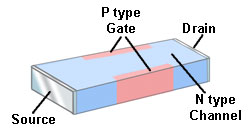Construction:

- The junction field effect transistor (JFET) in which the electrons as majority charge carriers due to this only current conduction takes place is known as N channel JFET.
- The N-channel JFET consist N type semiconductor that is silicon bar with two P type heavily doped regions distributed on opposite sides of its middle part.
- The two PN junctions are formed by P type regions and the space between the junctions that is N type regions is known as a channel.
- A single wire is taken out in the form of a terminal when both the P type regions are connected internally is known as the gate (G).
- The electrical connection which is also called as ohmic contacts are made to both ends of N-type semiconductor and are taken in the form of two terminal called as source (S) and drain (D).
- The electrons enter thesemiconductor through the source (S) terminal and the drain (D) terminal in which the electrons leave the semiconductor.
